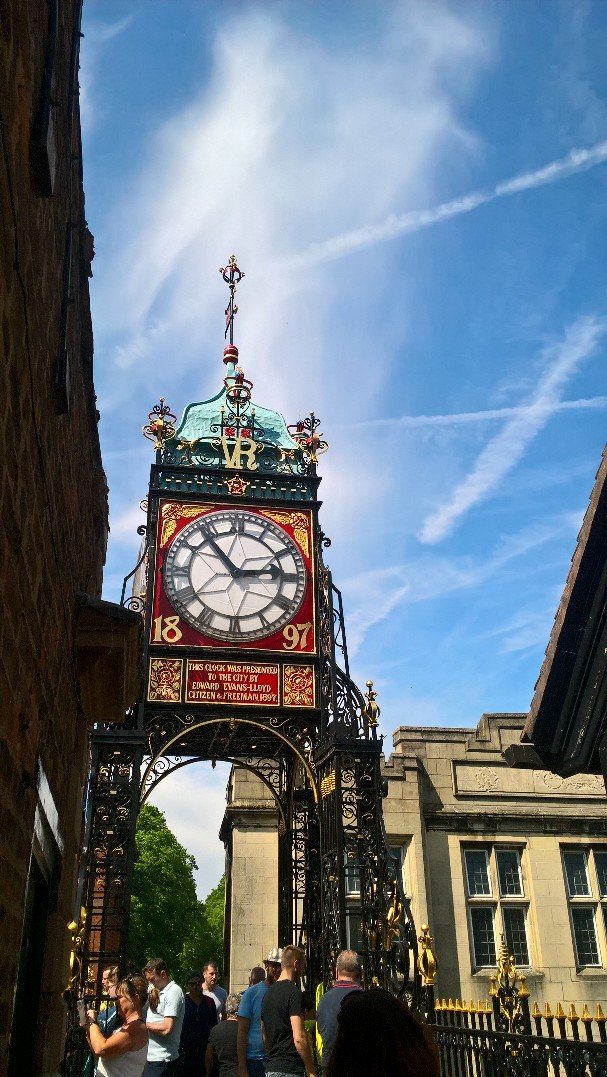Clocks
Read about four clocks in Chester, interleaved with reflections on time.
i
On 27 May 1899 – Queen Victoria’s 80th birthday – the Eastgate Clock sprang into life as the Mayoress of Chester pulled a tassel set by clockmaker Mr Joyce of Whitchurch. Colonel Evans-Lloyd, a donor, presented the clock and hoped it would provide comfort, convenience, and aesthetic value to both residents and tourists. It has met the Colonel’s wish and then some.
ii
The Eastgate Clock is marketed as England’s second most photographed clock (after Big Ben). I don’t know how the stats are captured but no one would contest this factoid – I can’t remember crossing Eastgate and not seeing someone taking a snap. After the Town Hall had been built in 1869, the city decided that Eastgate looked a bit dull so…voila!
iii
For the Victorians, ornateness was a way of being, and it is hard to imagine Chester now without this jolly confection of a clock watching over passers-by 24/7. The ironwork was crafted by blacksmith James Swindley at the Handbridge forge half a mile away. (The forge is now an orthodontist’s – it has gone from bending iron to straightening teeth).
iv
Chester Town Hall was opened by the Prince of Wales (later Edward VII) in 1869 accompanied by Prime Minister Gladstone. The clock was only fitted in 1979 and famously only has three faces. The clock tower is based on the Cloth Hall at Ypres. The tower must have been designed for a clock because the circle has 12 circular dots…
v
Humans have ten digits, so why are so many things based on twelve including how we carve up time (Zodiac, Apostles, Tribes of Israel, Days of Christmas…). Twelve was important to the Sumerians and to the Egyptians and there are twelve lunar cycles in a year. Exclude the thumb and there are twelve sections on the fingers of each hand.
vi
The names of our months are brought to us by the Romans. January from the Roman god Janus (god of doors and beginnings). March (the first month in the Roman world) is from Mars the god of war. July and August from Julius and Augustus Caesar. Running out of inspiration, September through December are based on numbers 7 to 10.
vii
Another Chester clock of note is the one at the front of Chester Railway Station. Nothing fancy, this one is important to me because it tells me how fast I need to walk or run to avoid missing the train. Compared to the scramble of driving, the railways are a civilised way to travel and they are often on time.
viii
It was Lewis Mumford who first drew our attention to the fact that clocks are both ingenious and a tool of capitalism (the drive for ever more productivity and the idea that “time is money”) and indeed the railways needed consistency of time which led in 1874 to Greenwich Mean Time. Charlie Chaplin nailed this idea better in Modern Times.
ix
For most of history we have based timekeeping on the movement of the sun and the stars across the sky caused by earth rotating about its own axis. Sundials only work when the sun shines, so we developed mechanical clocks (water clocks, candle clocks, hourglasses, pendulum clocks). The Earth’s rotation was the “master clock” until we embraced the atomic clock.
x
Inscribed in a clock case inside Chester Cathedral is a poem called Time’s Paces attributed to Henry Twells. The poem is about how time speeds up as you get older. I think a lot of this has to do with us getting better at predicting as we age – the risk being that life becomes boring as it gets more predictable.
xi
A popular (wrong) piece of folk science is that all mammals are allotted a similar number of heartbeats. A shrew’s heart can tick at 1000 bpm, the blue whale’s below 10bpm. Mr Joyce maker of the Eastgate Clock would be astonished that many people passing under it have a smartwatch counting time and the pace of their 3 billion ticks.
xii
This essay has 12 paragraphs of 60 words, covering four clocks that watch over Chester (representing beauty, the state, industry, and the church). The story of timekeeping is one of human ingenuity, and our relationship to time has shifted. Poets explain that best: Philip Larkin told us that “days are where we live” and they are to be happy in.
Here are eight milestones in the history of timekeeping from the last 1000 years.

